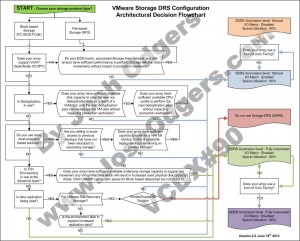Problem Statement
In a vSphere environment, What is the most suitable Datastore (LUN) sizing to use for to support both production & development workloads to ensure minimum storage overhead and optimal performance?
Requirements
1. RTO 4hrs
2. RPO 12hrs
3. Support Production and Test & Development Workloads
4. Ensure optimal storage capacity utilization
5. Ensure storage performance is both consistent & maximized
6. Ensure the solution is fully supported
7. Minimize BAU effort (Monitoring)
Assumptions
1. Business critical applications are excluded
2. Block based storage
3. VAAI is supported and enabled
4. VADP backups are being utilized
5. vSphere 5.0 or later
6. Storage DRS will not be used
7. SRM is in use
8. LUNs & VMs will be thin provisioned
9. Average size VM will be 100GB and be 50% utilized
10. Virtual machine snapshot will be used but not for > 24 hours
11. Change rate of average VM is <= 15% per 24 hour period
12. Average VM has 4GB Ram
13. No Memory reservations are being used
14. Storage I/O Control (SOIC) is not being used
15. Under normal circumstances storage will not be over committed at the storage array level.
16. The average maximum IOPS per VMs is 125 (16Kb) (MBps per VM <=2)
17. The underlying storage has sufficient performance to cater for the average maximum IOPS per VM
18. A separate swap file datastore will be configured per cluster
Constraints
1. Must used existing storage solution (Block Based Storage)
Motivation
1. Increase flexibility
2. Ensure physical disk space is not unnecessarily wasted
3. Create a Scalable solution
4. Ensure high performance
5. Ensure high utilization of storage resources by reducing “islands” of unused capacity
6. Provide flexibility in the unit size of partial SRM failovers
Architectural Decision
The standard datastore size will be 3TB and contain up to 25 standard virtual machines.
This is based on the following
25 VMs per datastore X 100GB (Assumes no over commitment) = 2500GB
25 VMs w/ 4GB RAM = 100GB minus 0Gb reservation = 100GB vswap space to be stored on the swap file datastore
25 VMs w/ Snapshots of up to 15% = 375GB
Total = 2500GB + 375GB = 2875GB
Average capacity used per VM = 115GB
Justification
1. In worst case scenario where every VM has used 100% of its VMDK capacity and has 4GB RAM with no memory reservation and a snapshot of up to 15% of its size the 3TB datastore will still have 197GB remaining, as such it will not run out of space.
2. The Queue depth is on a per datastore (LUN) basis, as such, having 25 VMs per LUNs allows for a minimum of 1.28 concurrent I/O operations per VM based on the standard queue depth of 32 although it is unlikely all VMs will have concurrent I/O so the average will be much higher.
3. Thin Provisioning minimizes the impact of situations where customers demand a lot of disk space up front when they only end up using a small portion of the available disk space
4. Using Thin provisioning for VMs increases flexibility as all unused capacity of virtual machines remains available on the Datastore (LUN).
5. VAAI automatically raises an alarm in vSphere if a Thin Provisioned datastore usage is at >= 75% of its capacity
6. The impact of SCSI reservations causing performance issues (increased latency) when thin provisioned virtual machines (VMDKs) grow is unlikely to be an issue for 25 low I/O VMs and with VAAI is no longer an issue as the Atomic Test & Set (ATS) primitive alleviates the issue of SCSI reservations.
7. As the VMs are low I/O it is unlikely that there will be any significant contention for the queue depth with only 25 VMs per datastore
8. The VAAI UNMAP primitive provides automated space reclamation to reduce wasted space from files or VMs being deleted
9. Virtual machines will be Thin provisioned for flexibility, however they can also be made Thick provisioned as the sizing of the datastore (LUN) caters for worst case scenario of 100% utilization while maintaining free space.
10. Having <=25 VMs per datastore (LUN) allows for more granular SRM fail-over (datastore groups)
Alternatives
1. Use larger Datastores (LUNs) with more VMs per datastore
2. Use smaller Datastores (LUNs) with less VMs per datastore
Implications
1. When performing a SRM fail over, the most granular fail over unit is a single datastore which may contain up to 25 Virtual machines.
2. The solution (day 1) does not provide CapEx saving on disk capacity but will allow (if desired) over commitment in the future
Thanks to James Wirth (VCDX#83) @JimmyWally81 for his contributions to this example decision.
Related Articles
1. Datastore (LUN) and Virtual Disk Provisioning (Thin on Thick)
2. Datastore (LUN) and Virtual Disk Provisioning (Thin on Thin)
3. Virtual Machine vSwap Location


